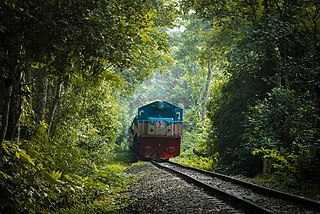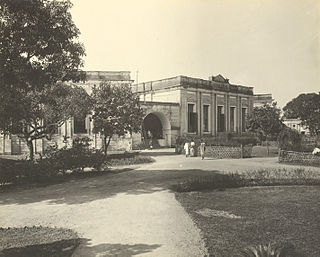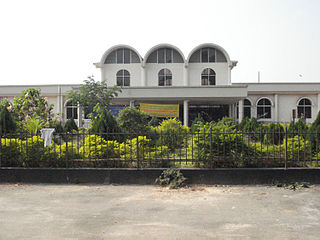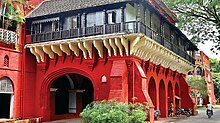
Chittagong, officially Chattogram, is the second-largest city in Bangladesh. Home to the Port of Chittagong, it is the busiest port in Bangladesh and the Bay of Bengal. It is the administrative seat of an eponymous division and district. The city is located on the banks of the Karnaphuli River between the Chittagong Hill Tracts and the Bay of Bengal. The Greater Chittagong Area had a population of more than 5.2 million in 2022. In 2020, the city area had a population of more than 3.9 million. The city is home to many large local businesses and plays an important role in the Bangladeshi economy.

Gauḍa is a historic city of Bengal in the eastern part of the Indian subcontinent, and one of the most prominent capitals of classical and medieval India, being the capital city of Bengal under several kingdoms. The Gauḍa region was also a province of several pan-Indian empires. During the seventh century, the Gour Kingdom was founded by King Shashanka, whose reign corresponds with the beginning of the Bengali calendar. Gour gradually became synonymous with Bengal and Bengalis. It was conquered by Bakhtiyar Khalji, a lieutenant of the Ghurid ruler Muhammad of Ghori in 1203.

Binat Bibi Mosque is the earliest surviving mosque in Dhaka built in 1454 by Bakht Binat, the daughter of Marhamat. It was built during the rule of the Sultan of Bengal, Nasiruddin Mahmud Shah (1435–1459). The mosque is located beside the Hayat Bepari’s Bridge in Narinda area.

Indo-Islamic architecture is the architecture of the Indian subcontinent produced by and for Islamic patrons and purposes. Despite an initial Arab presence in Sindh, the development of Indo-Islamic architecture began in earnest with the establishment of Delhi as the capital of the Ghurid dynasty in 1193. Succeeding the Ghurids was the Delhi Sultanate, a series of Central Asian dynasties that consolidated much of North, East, and Central India, and later by the Mughal Empire during the early 16th century. Both of these dynasties introduced Islamic architecture and art styles from West Asia into the Indian subcontinent.

The Chittagong Port is the main seaport of Bangladesh. Located in Bangladesh's port city of Chittagong and on the banks of the Karnaphuli River, the port handles over 90 percent of Bangladesh's export-import trade, and has been used by India, Nepal and Bhutan for transshipment. According to Lloyd's, it ranked as the 58th busiest container port in the world in 2019. The port has a recorded history dating back to ancient Roman accounts. It is the busiest container port on the Bay of Bengal.

The Architecture of Bengal, which comprises the modern country of Bangladesh and the Indian states of West Bengal, Tripura and Assam's Barak Valley, has a long and rich history, blending indigenous elements from the Indian subcontinent, with influences from different parts of the world. Bengali architecture includes ancient urban architecture, religious architecture, rural vernacular architecture, colonial townhouses and country houses and modern urban styles. The bungalow style is a notable architectural export of Bengal. The corner towers of Bengali religious buildings were replicated in medieval Southeast Asia. Bengali curved roofs, suitable for the very heavy rains, were adopted into a distinct local style of Indo-Islamic architecture, and used decoratively elsewhere in north India in Mughal architecture.

Bara Katra is one of the oldest historical and architectural monuments in Dhaka. The word Katra may have originated from Arabic word Katara which means colonnaded building. 'Katra/ katara' in Arabic and Persian means 'Caravan (Karwan) Sarai' or simply a 'Sarai'. It is a palatial building dating to the reign of the Mughal dynasty in the Bengal region. It is situated to the south of Chowk Bazaar close to the north bank of the river Buriganga. It was partially demolished in 2022.

Eastern Bengal and Assam was a province of India between 1905 and 1912. Headquartered in the city of Dacca, it covered territories in what are now Bangladesh, Northeast India and Northern West Bengal.

Cooch Behar Palace is a landmark in Cooch Behar city, West Bengal. It was designed in the Italian Renaissance architecture style and was built in 1887, during the reign of Maharaja Nripendra Narayan of Koch dynasty. It is currently a museum.

Oakmere Hall is a large house to the southwest of the villages of Cuddington and Sandiway, Cheshire, England, near the junction of the A49 and A556 roads. It is recorded in the National Heritage List for England as a designated Grade II listed building. It was originally a private house and later became a rehabilitation centre and hospital. It has since been divided into residential apartments.

Montrest is a house on Lane Gate Road outside Nelsonville, New York, United States. It was built after the Civil War as a summer residence by Aaron Healy, a successful New York leather dealer, to take advantage of panoramic views of the Hudson River and surrounding mountains of the Highlands.

Mitford Hospital is a public hospital in Dhaka, Bangladesh. Situated in the historic Old Dhaka area, the hospital serves as a teaching hospital of Sir Salimullah Medical College.

The Singar Mosque is a 15th-century mosque that forms a part of the Mosque City of Bagerhat, a designated World Heritage Site in the southwestern region of Bangladesh. This mosque is characterized by its single-domed, square structure constructed with exposed brick and adorned with terracotta decorations.
The Pakistan Eastern Railway was one of two divisions of Pakistan Railways which operated between 1961 and 1971. The company was headquartered in Chittagong. With the emergence of Bangladesh, it became Bangladesh Railway.

Farhād Khān, also known as Nizam-e-Zamanah or Nizam-e-Zaman, was a Mughal military strategist who had many positions throughout his life. He was the most well-known Faujdar of Sylhet Sarkar, governing in the late 17th century during the reign of Mughal emperor Aurangzeb. He was renowned for the construction of numerous bridges and places of worship in the region.

The Shah Jalal Dargah is the shrine and burial place of the 14th century Muslim saint Shah Jalal, located in Sylhet, Bangladesh. The site, known as a dargah, was originally constructed c. 1500, though many additions and alterations were made to its structures over the following centuries. It became a religious centre in the region, respected across multiple ruling administrations and greatly venerated among Bengalis, with local folklore and legends developing around it. The extensive surrounding compound serves several functions and includes four mosques, a religious school and a public cemetery among others. The Dargah is presently the largest and most visited religious site in Bangladesh.
Chittagong–Cox's Bazar line is a railway line under Bangladesh Railway. It is operated by East Zone of Bangladesh.
Faqir Mosque is an oblong six-domed Islamic place of worship in Bangladesh's Chittagong District. The fifteenth-century mosque dates back to the Bengal Sultanate period.

Akhaura Junction railway station is a railway junction located in Akhaura Upazila, Brahmanbaria District, Chittagong division, Bangladesh.




























